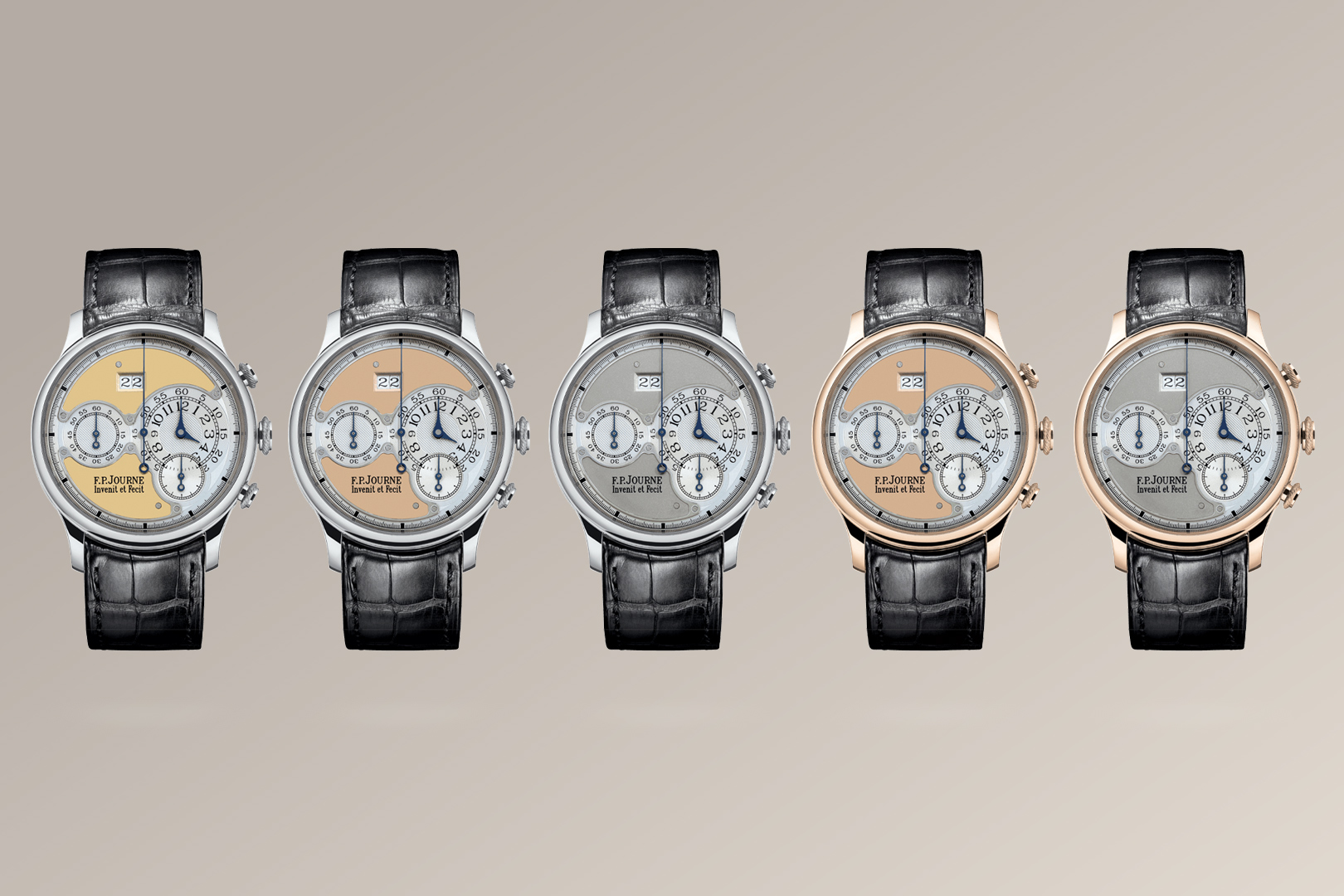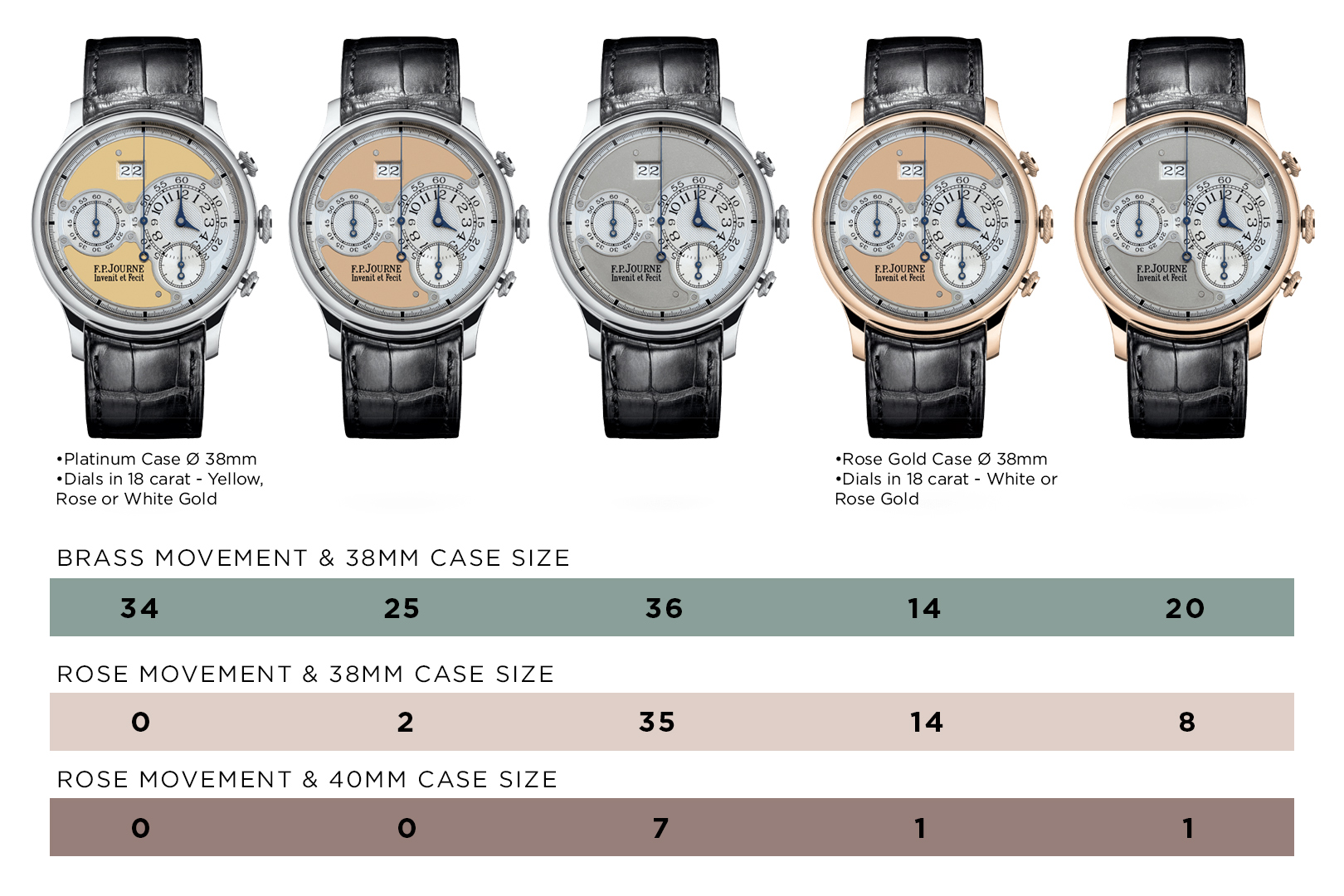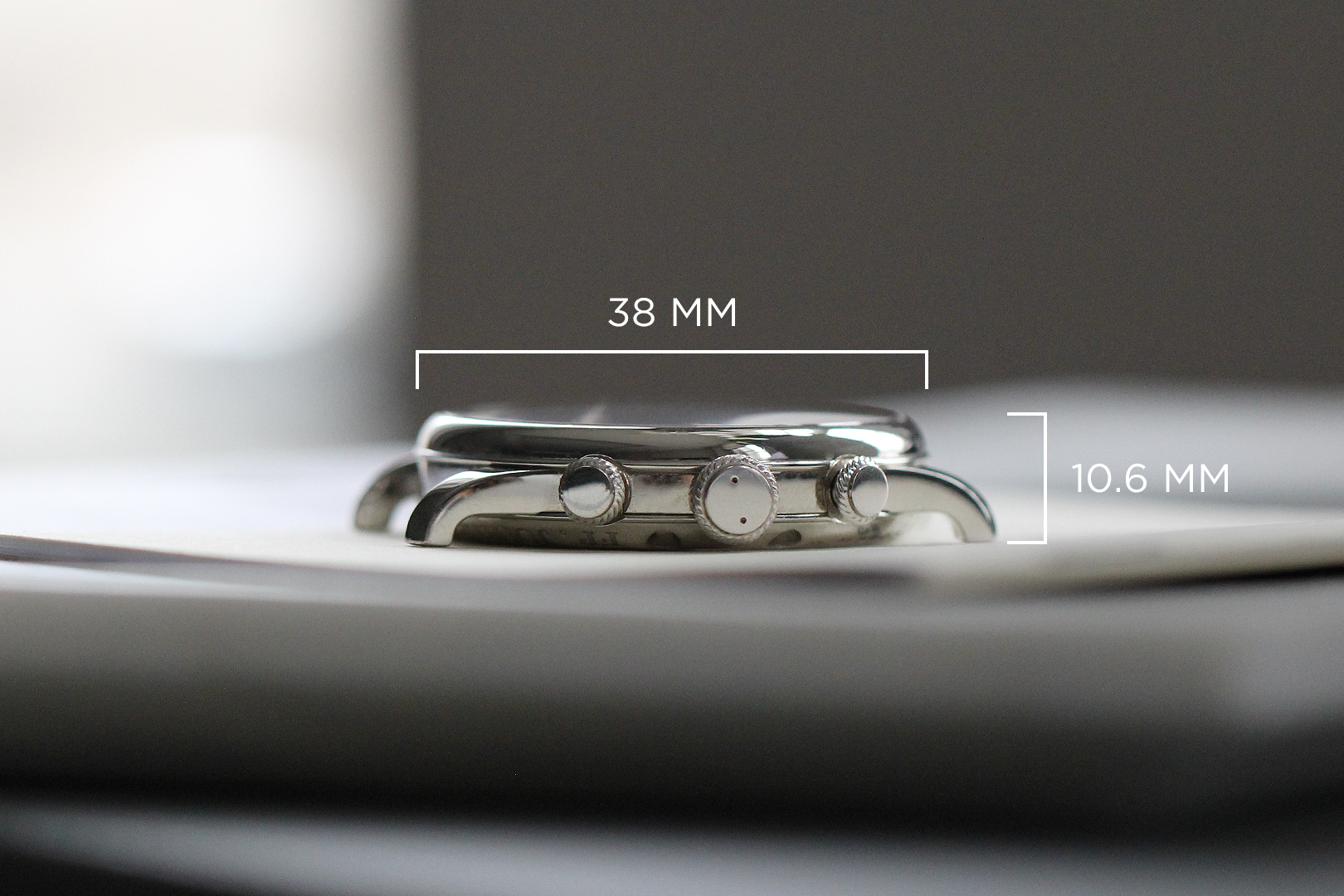
Uncategorized
A Collector’s Guide for the Octa Chronographe by F. P. Journe
By adminThe journey of a watchmaker differs from case to case, the story of François-Paul Journe is unlike any other. The pillars of François-Pauls success can be attributed to the unwavering support and encouragement of his mother and uncle’s (Mr Michel Journe).
François-Paul did not possess a clear-cut path into horology, some of his teachers simply instructed him to find another calling. After having being expelled from the Lycée Laperrine d’Apprentissage Technique, François-Paul joined his uncle, Mr. Michel Journe in Paris. In tandem, Francois-Paul continued to study at the École d’Horlogerie de Paris. Michel Journe newly built workshop, found on Rue de Verneuil, would leave a profound impact on François-Paul. His uncle, a gifted restorer, was entrusted in his craft by some of the most influential collectors in the world such as Edmond de Rothschild. The tact to restore some of these time-capsules required a tremendous amount of skill; due to the fact that spare parts were nearly impossible to come by, often resulting in parts having to be remade and reimagined. Unsurprisingly, being surrounded by this atmosphere inspired François-Paul to build his highly respected brand F. P. Journe.
Today, F. P. Journe is considered to be one of the most important independent watchmakers. The constant innovation and sometimes mind-boggling creations cemented his name into the upper echelons of watchmaking with names such as Antide Janvier, Ferdinand Berthoud, A. L. Breguet, and George Daniels.
The brand would best be described as the largest independent watch brand (that practices a form of semi-artisanal watchmaking, in turn) this allows production to hover around 650-850 pieces per year. In line with traditional artisanal watchmaking, each watchmaker is responsible for their watch from inception until completion. To say that production is capped is not wholly accurate; if the brand opted to produce only Chronomètre’s Souverains, production could reach 1500 pieces per annum, whereas, if only the Astronomic (the most complicated watch created by the brand) were produced production could reach 10 pieces per year. Finding an equilibrium between production output is not a simple task. François-Paul understood the importance of having a vertically integrated company, Journe has subsequently built up his personal arsenal. The dial and case makers are now wholly owned by the brand.
We have decided to write an in-depth review of F. P. Journe’s earlier pieces, namely, the Octa Chrongraphe. In this review of the Octa Chronographe one can expect us to explore production numbers, compare models, identify the rarest of its kind, and track their performance over time. It is important to note that we have written this report independently and have been supported with data from fellow collectors, public domains, and the F. P. Journe Journal Volume III.
Brass Movement Era
F. P. Journe – Invenit et Fecit debut movements were all produced in brass from the years 1999 till 2004, it is said that no more than 2200 brass-based movements were created during that period. The following pieces were available in brass: Tourbillon Souverain, Chronomètre à Résonance, Octa Automatic, Octa Calendrier, Octa Chronographe and Octa Lune. It is important to note that the Octa’s (latin for “eight” or “infinite”) collection base calibre is 1300 which debut in the Octa Automatic Reserve de Marche. This calibre, 1300, is the base movement found across the Octa collection and is still used to date, albeit with updates throughout the years. All F. P. Journe calibre are four digits, the first two numbers represent the length of the movement in lignes and the latter represents the year (last two numbers of the year) the calibre was developed.
13 lignes + 2000 (year made)
calibre13 + 00 = 1300
Unsurprisingly, the Octa Chronographe is also fitted with calibre 1300, instead of adding a chronograph module, Journe decided to integrate the chronograph within the base calibre. This resulted in movement being unchanged in size, measuring 30mm in diameter and 5.7mm in thickness, the column wheel was essentially flattened into a cam wheel which allowed the entire complication to fit in a space of no more than 1mm.

The decoration of the movement varies throughout the production years, we explore this at a later stage. The main decoration techniques used during the brass era were hand-finished bevels as well as Côtes de Genève. Below are examples of different finishes found on the Octa Chronographe, we have identified two different variations. We do not exclude the possibility of there being additional decorative differences to the calibre, our observations are made from the information made available to us.
Decorative Findings
i. First Generation Calibre 1300
The first generation pieces feature straight Côtes de Genève, the outer finishing of the movement features a sort of raw circular ‘unfinished’ look. According to our data, there are only 10 pieces that feature the straight Côtes de Genève in brass.
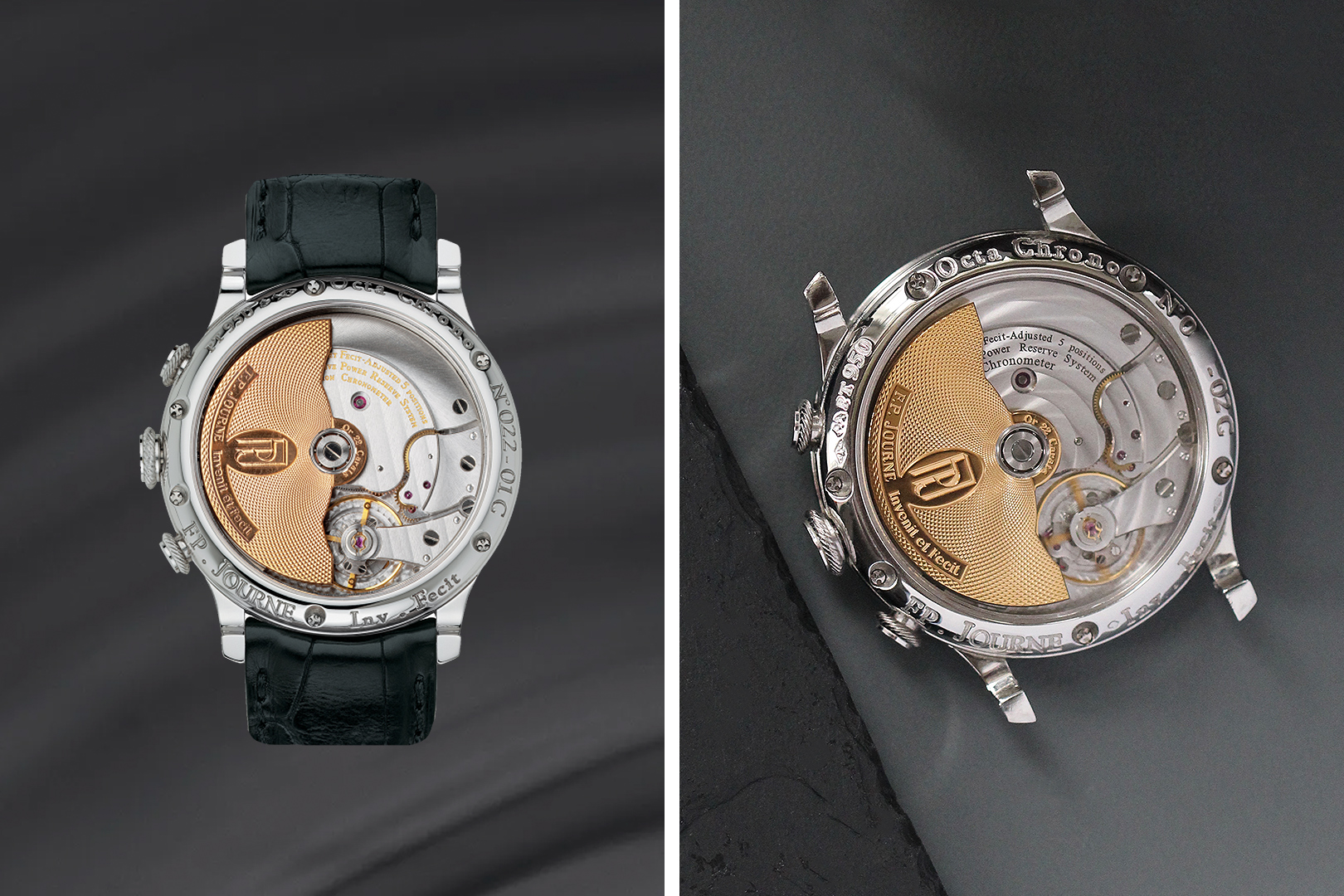
ii. Second Generation Calibre 1300
The second-generation brass pieces feature circular Côtes de Genève, the outer finish of the calibre is now in sync with the center. The circular Côtes de Genève is featured on the entire movement. According to our data, there are 125 pieces with this type of finish.
iii. Third Generation
The third generation pieces are solely attributable to the Octa Chronographe Ruthenium series. The movement and finish are identical to the second generation with the exception of the movement being coated in Ruthenium. According to our data, there are 100 pieces with this type of coating.
iv. Fourth Generation
The introduction of this calibre 1300.2 signified the end of the brass era. F. P. Journe. At the outset F. P. Journe always wanted to offer his collectors unique value propositions due to the extensive costs and lack of machinery F. P. Journe could not realise his immediate goal of producing all his movement out of 18-carat gold. In 2004, five years after the brand was founded, F. P. Journe was able to realise his goal of having 18-carat gold calibres this would represent one of the first brands to offer all calibres in gold. According to our data, there are 78 pieces with the gold movement.
v. Fifth Generation
The introduction of calibre 1300.3 in 2007 lay in the technical enhancement of the movement, swapping from bidirectional to a unidirectional rotor. Subsequently, the Octa Chronographe was then phased out in 2008 in favour of the newly introduced centigraphe. This is probably one of the rarest calibres.

The Calibre 1300 – Versatility & Observations
The base calibre 1300 features a world premiere 1-meter long spring that was capable of providing 850g of torque, as a result, this allowed the calibre to sustain a power reserve of 120 hours. The calibre beats at 3hz (21’600 vibrations per hour), the inertia blocks are used to accelerate or slow its speed by changing the radius of gyration, without affecting the balance-spring. F. P. Journe integrated the chronograph within this movement (below) within a tiny space measuring no more than 1mm by 1mm.
In light of the recent 20th Anniversary of the Octa Collection F. P. Journe stated the following:
After having made a new Tourbillon and a new Chronomètre à Résonance for their respective 20th Anniversaries, there will be no new automatic movement because I cannot do better than the one that already exists, 1300.3!
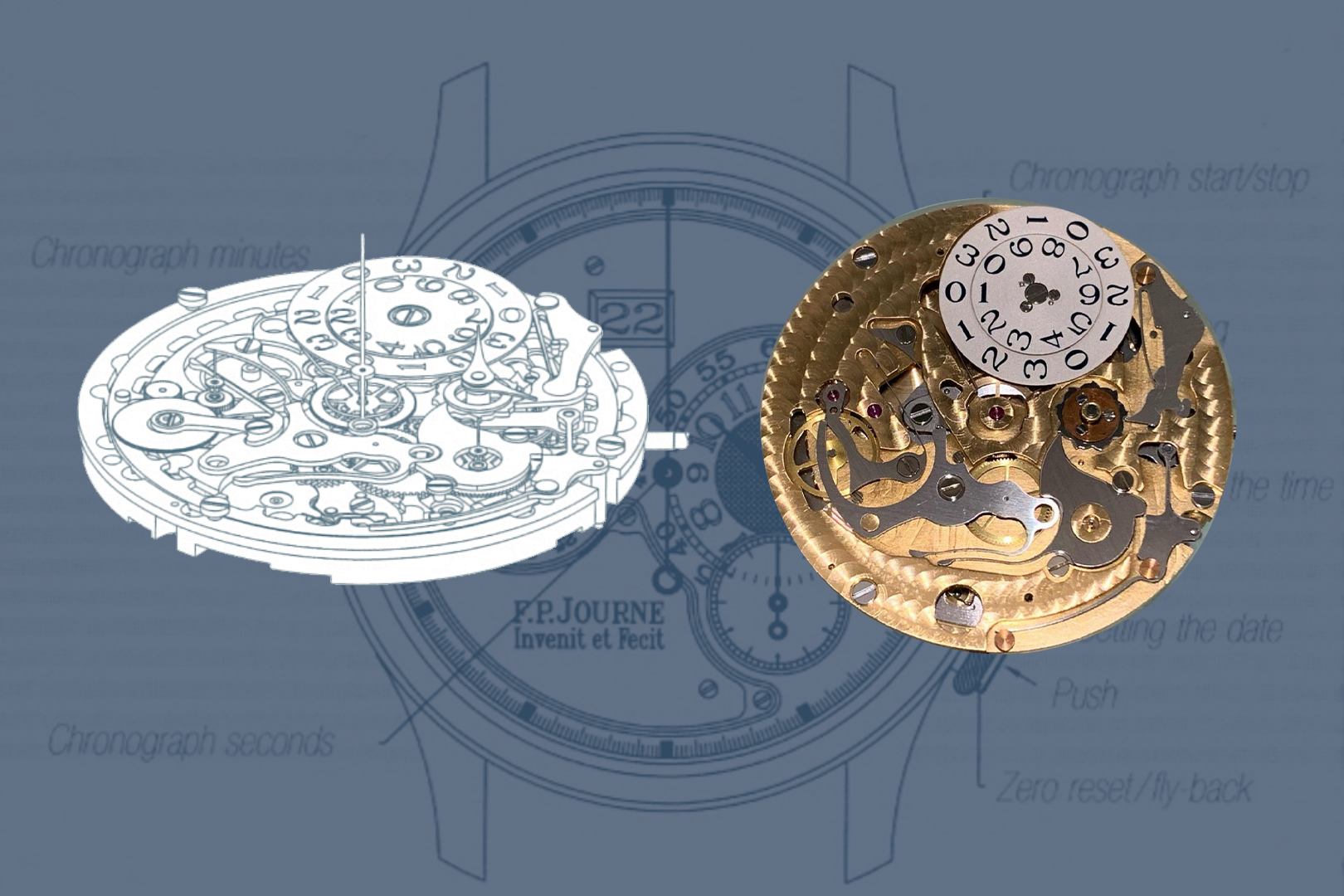
It is important to note that during the transition from the first generation to second generation movement, the calibre number remained the same, there was no change in its description. One might have expected François-Paul to have renamed the calibre 1300.1 (for the decorative changes, indicating a second-generation). However, since so few were finished with the straight CDG it did not make sense to ‘update’ the calibre. Moreover, it was not an update of the movement but rather an update on the decorative finishing of the movement. The ruthenium limited edition also features the calibre 1300 (which we have named the third generation).
It might not be wholly accurate to call these generations but rather an evolution of the first generation calibre 1300. The real fundamental change in the calibre description occurs in 2004 whereby F. P. Journe now exclusively produces all their movements in 18k rose gold. It is extremely easy to distinguish from the first three generations: brass straight CDG, brass circular CGD, brass coated in ruthenium and now 18k rose gold. All 18k rose gold movements are labelled calibre 1300.2 which indicates the update.
1300 Vs. 1300.2
The movement remains identical and unchanged in terms of functionality, both movements measure the same: thickness: 5.70mm and overall width: 30mm, the number of components remains the same 254 excluding the case and 32 jewels respectively. The only change is the alloy used, brass to 18K pink gold.
1300.2 Vs. 1300.3
The introduction of this calibre in 2007 was due to the change from a bidirectional to unidirectional rotor. Subsequently, the Octa Chronographe was then phased out in 2008 in favor of the Centigraphe.
Octa Chronographe Production
The table below illustrates the total production of the Octa Chronographe, in total, there are 313 pieces made across the entire collection. The breakdown comprises of the following, brass-based movements = 135, ruthenium = 100, gold-based movements = 78.
|
Case Size |
Case Material |
Movement Material |
Movement Finish |
Dial Color |
Quantities Produced |
|
38mm |
Rose gold |
Brass |
CDG Straight |
White Gold |
2 |
|
38mm |
Rose gold |
Brass |
GDG Straight |
Rose gold |
2 |
|
38mm |
Rose gold |
Brass |
CDG Circular |
White Gold |
18 |
|
38mm |
Rose gold |
Brass |
CDG Circular |
Rose gold |
12 |
|
38mm |
Rose gold |
Brass |
CDG Circular |
Nacre Noir |
6 |
|
38mm |
Platinum |
Brass |
CDG Straight |
White Gold |
1 |
|
38mm |
Platinum |
Brass |
CDG Straight |
Yellow Gold |
3 |
|
38mm |
Platinum |
Brass |
CDG Straight |
Rose gold |
2 |
|
38mm |
Platinum |
Brass |
CDG Circular |
White Gold |
35 |
|
38mm |
Platinum |
Brass |
CDG Circular |
Yellow Gold |
31 |
|
38mm |
Platinum |
Brass |
CDG Circular |
Rose gold |
23 |
|
38mm |
Rose gold |
Gold |
CDG Circular |
White Gold |
8 |
|
38mm |
Rose gold |
Gold |
CDG Circular |
Rose gold |
14 |
|
40mm |
Rose gold |
Gold |
CDG Circular |
White Gold |
1 |
|
40mm |
Rose gold |
Gold |
CDG Circular |
Rose gold |
1 |
|
38mm |
Platinum |
Gold |
CDG Circular |
Nacre Noir |
2 |
|
38mm |
Platinum |
Gold |
CDG Circular |
White Gold |
35 |
|
38mm |
Platinum |
Gold |
CDG Circular |
Rose gold |
2 |
|
40mm |
Platinum |
Gold |
CDG Circular |
White Gold |
7 |
|
40mm |
Platinum |
Gold |
CDG Circular |
Red / Black |
8 |
|
40mm |
Platinum |
Ruthenium |
CDG Circular |
Ruthenium |
100 |
On the whole, many collectors assumed that the brass-based movements were the rarest of the lot. When analyzing the data further, it is important to segregate the movement/dial configurations in order to determine which pieces can be deemed the rarest.
Section 1.1 – Total Brass Production
|
Total Brass Movement (38mm) 135 pieces | ||
|
DIALS |
Rose |
39 |
|
White |
56 | |
|
Yellow |
34 | |
|
Other |
6 |
Section 1.2 – Brass Production Breakdown
|
Rose Gold Case / Brass Movement (38mm) 40 pieces | CDG S | CDG C | ||
|
DIALS | Rose | 14 | 2 | 12 |
| White | 20 | 2 | 18 | |
| Yellow | 0 | 0 | 0 | |
| Nacre Noir | 6 | 0 | 6 | |
|
Platinum Case / Brass Movement (38mm) 95 pieces | CDG S | CDG C | ||
|
DIALS | Rose | 25 | 2 | 23 |
| White | 36 | 1 | 35 | |
| Yellow | 34 | 3 | 31 |
Section 1.3 – Gold Production Breakdown
|
Rose Gold Case 38mm Breakdown | ||
|
DIALS | Rose | 14 |
| White | 9 | |
| Yellow |
NA | |
|
Rose Gold Case 40mm Breakdown | ||
|
DIALS | Rose | 1 |
| White | 1 | |
| Yellow | NA | |
|
Platinum Case 38mm Breakdown | ||
|
DIALS | Rose | 2 |
| White | 35 | |
| Yellow |
NA | |
| Nacre Noir | 2 | |
|
Platinum Case 40mm Breakdown | ||
|
DIALS | Rose | |
| White | 7 | |
| Red Black (Ltd) | 8 | |
|
Platinum Case 40mm Ruthenium Set | ||
|
40mm | Ruthenium | 99 |
|
38mm | Ruthenium* | 1 |
* We cannot confirm whether this piece exists or not, we do know of a 38mm Ruthenium Résonance.
A Further Analysis of the Production Numbers
On the whole many speculate that the brass movements are the rarest, according to our data it would suggest otherwise. Brass movements account for 135 pieces whereas rose gold movements account for 78 pieces. Despite being a limited edition the ruthenium series is the most common with 100 pieces.
Brass Era Vs. Rose Gold
According to our data, the rose gold cases fitted with brass movements (40 pieces) are much rarer than brass movements fitted in platinum cases (95 pieces). The image below demonstrates the configurability of the case to dials along with the production numbers. The first row in grey indicates the brass movements whereas the second row in beige indicates the production numbers in rose gold movements. It is important to note that F. P. Journe does not offer the rose gold case with a yellow gold dial.
We have not included any limited editions or special editions into consideration, that being said there were several editions made. We would like to mention that a limited edition usually has a new set of serial numbers … starting from 00 till the last number of the edition. For instance the ruthenium series would be 00/99 till 99/99 indicating that there are 100 pieces. From our understanding the two other special editions were made for two retailers (Swiss Fine Time & Sincere), below is a list of special editions:
- 38mm, rose gold case, Nacre Noire 6 pieces (brass movement)
- 38mm, platinum case, Nacre Noire 2 pieces (gold movement)
- 40mm, platinum case, Red Black 8 pieces (gold movement)
- 38mm, platinum case, Ruthenium, 1 piece (ruthenium movement) **
** – this is rumoured although we do not possess any data that confirms this.
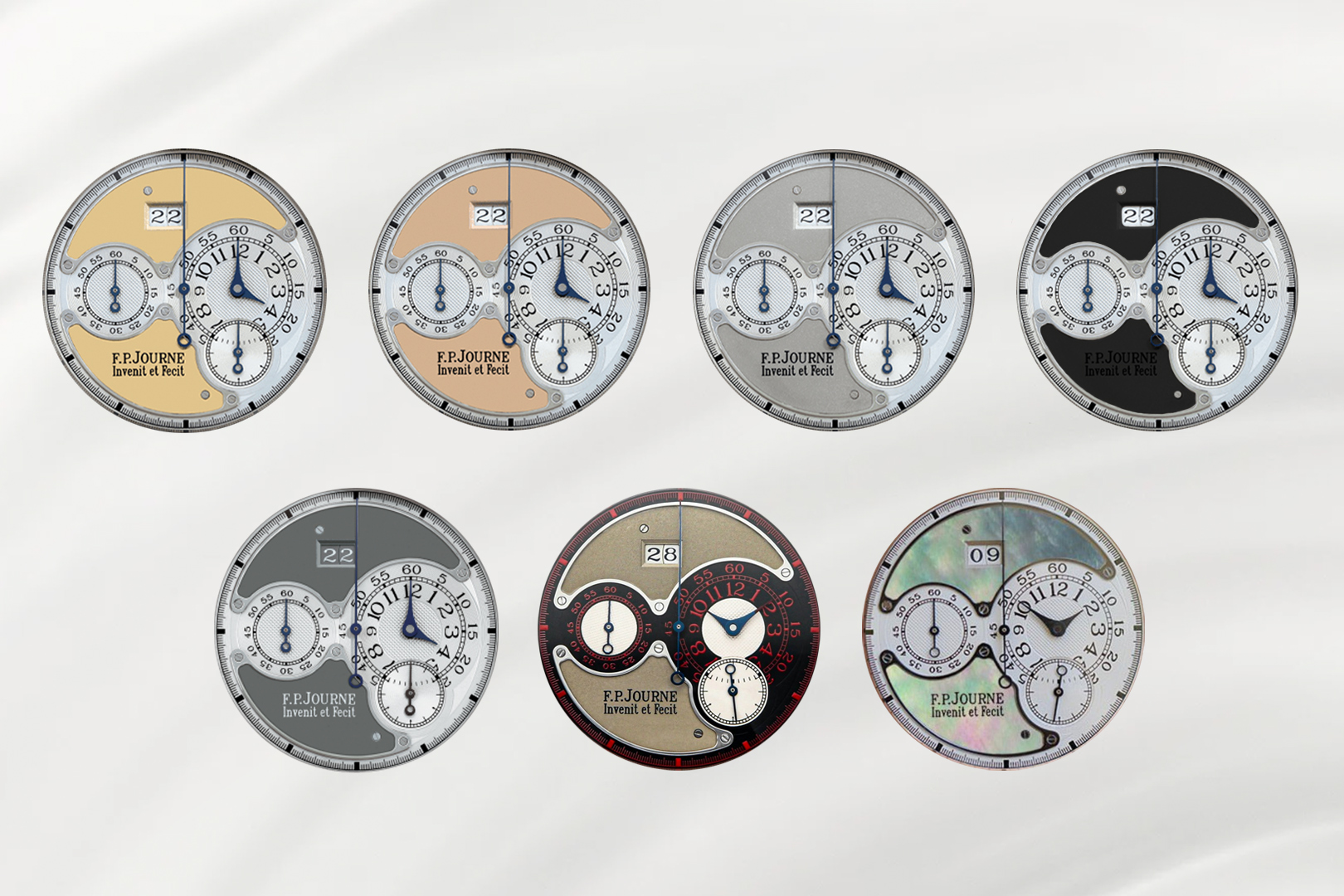
Identifying the Rarest
During the brass era, the rarest configuration is the 38mm rose gold case paired with the rose gold dial according to our data only 14 pieces were produced, 2 of the 14 are said to be decorated with straight Côtes de Genève whereas the 12 other feature Circular Côtes de Genève. The second-rarest would be the rose gold case paired with the white gold dial according to our data only 20 pieces were produced, 2 of the 20 are said to be decorated with straight Côtes de Genève whereas the 16 other feature circular Côtes de Genève. It is interesting to note that the two rarest configurations are housed in rose gold cases as opposed to the platinum cases. One could argue that the platinum cases were more sought after and hence the discrepancy. Amongst the platinum cases, the rose dial is the rarest only 25 were made, 2 of the 25 are said to be decorated with Straight Côtes de Genève whereas the 23 other feature Circular Côtes de Genève. The quintessential yellow dial was produced 34 times, 3 of the 34 are said to be decorated with Straight Côtes de Genève whereas the 31 other feature circular Côtes de Genève.
1300.2 Era (38mm – Journe moves to full gold movement):
F. P. Journe essentially phases out the yellow dial from hereon, we cannot assess whether this was done on purpose or not. That being said the rarest 38mm case size paired with the rose gold movement is the platinum case paired with the rose dial according to our data only 2 pieces were produced. Despite the numerous limited editions made for the Octa Chronographe collection, this is technically rarer than any of the limited editions made. The second-rarest would be the rose gold case paired with the white gold dial according to our data only 8 pieces were made.
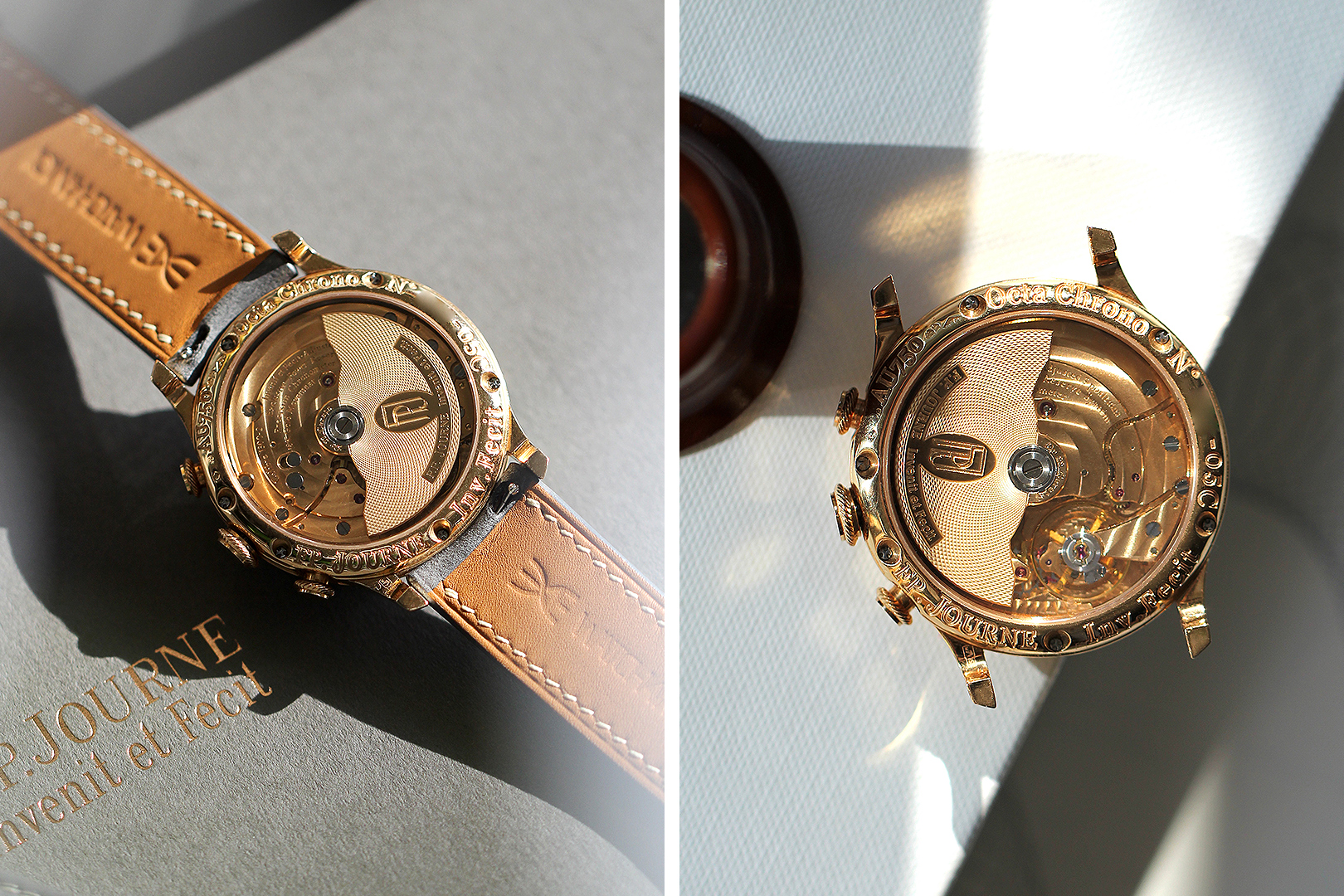
1300.3 Era (Bidirectional Vs. Unidirectional):
The 40mm case size is now available within the collection with the new calibre 1300.3 according to our data the rarest pieces are, once again, housed in rose gold cases with a rose and white dial, 2 were produced total (one of each). It is important to highlight that the production span was extremely short, for starters the calibre 1300.3 was introduced in 2007 and the Octa Chronographe was discontinued in 2008 (if not earlier as F. P. Journe usually discontinues watches slightly before SIHH which takes place during the third week of January on a yearly basis).
Limited Editions Vs. Series:
It is important to define the term-limited, some collectors argue that a limited edition should be quantifiable, for instance, the OC Ruthenium starts from 00/99 – XXC till 99/99 – XX/C (XX represents the last two digits of the year). That essentially means that if you were to track all owners there should only be 100 in the world, whereas the other limited editions would best be defined as limited by production (or series), certain brands over / understate the number of pieces made, whereas F. P. Journe, prides himself on keeping his word. The ruthenium OC is the most serially produced piece in the entire collection, despite the fact that it is the only limited edition that is numbered on the case-back.
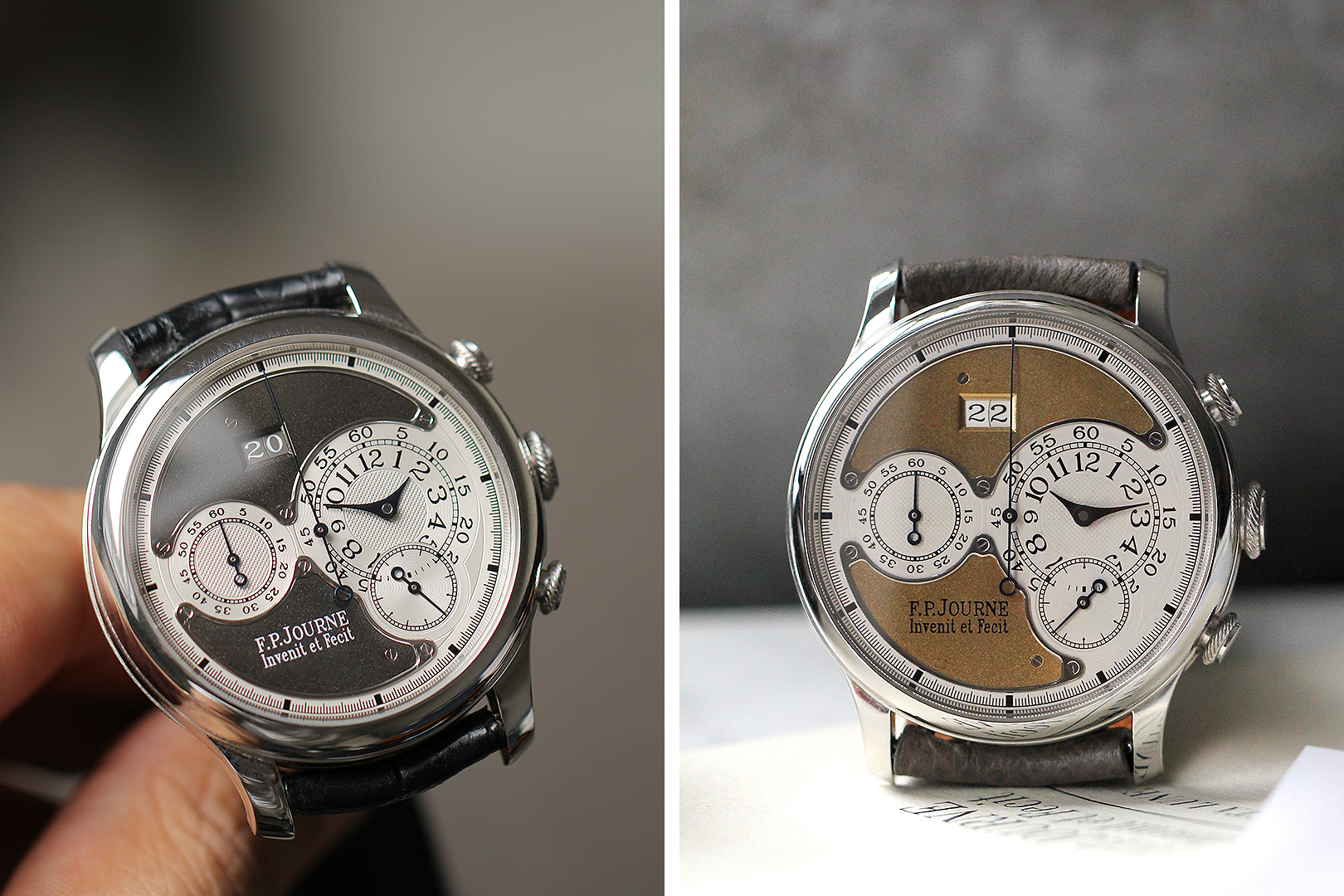
For example, Swiss Fine Time a retailer based in Chicago, commissioned a set of Chronomètre Souverain, Octa Chronographe and wall clock which was limited to 8 examples per item.

The image above displays the piece made for Swiss Fine Time ( along with other limited editions), it is said that only 8 of these were ever produced. A full set is also accompanied by an attestation from F. P. Journe stating that the series was limited to eight examples only (printed in red ink).
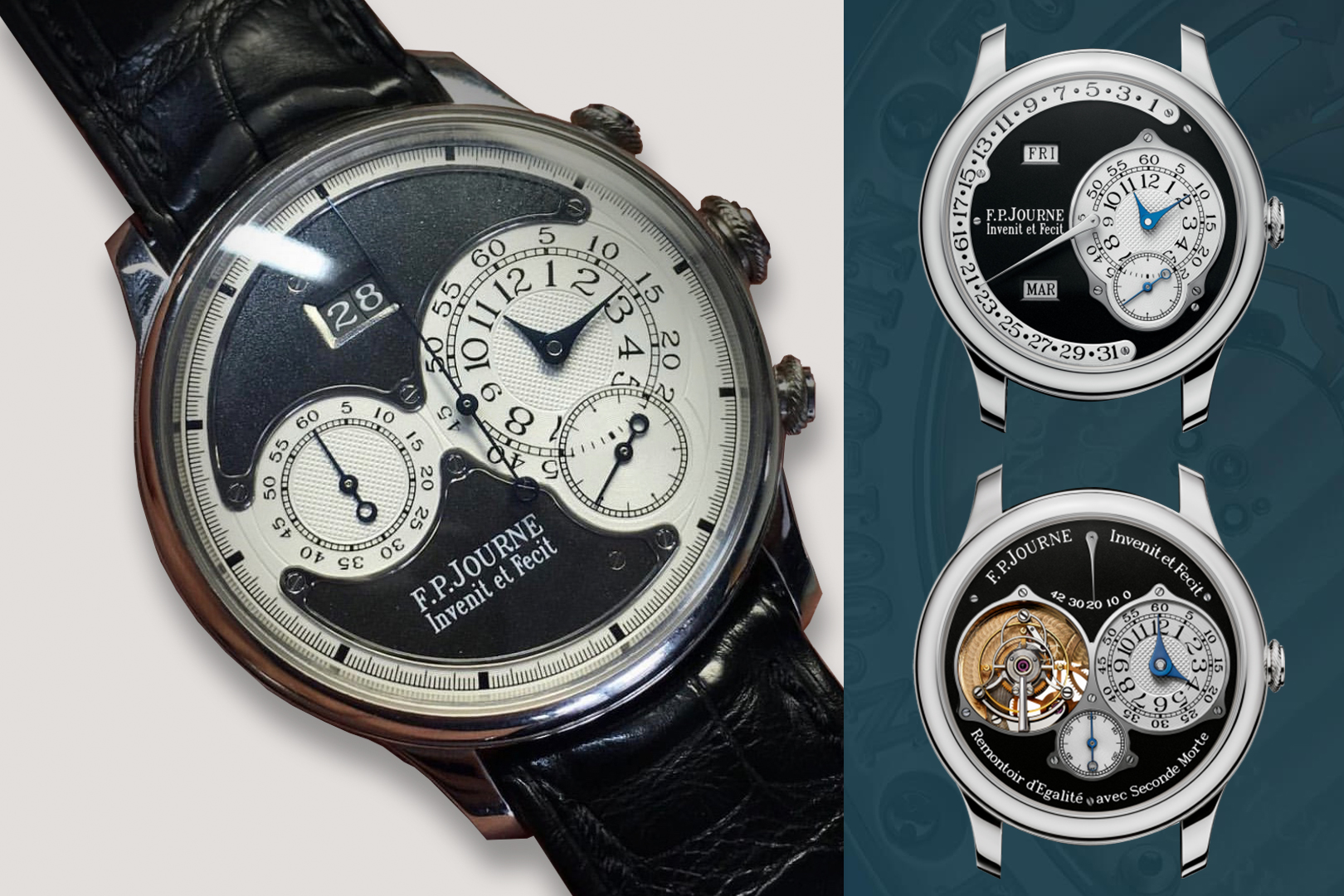
One of the rarest, limited by production, is the black labels it is said that only 2 pieces exist in this configuration. Moreover, the concept of the black label series had not been introduced to the public yet, we could argue that these were produced as a potential prototype black dial. The black label series was introduced in 2008 with the intention of being a boutique / Espace exclusive and only existing clients, preferably owning two or more F. P. Journes, could purchase these pieces. It is said that the respective Espace or boutiques were only permitted to order two black labels per reference for the year. By the time F. P. Journe publicly announced the Black Label series, the Octa Chronographe had ceased production in favour of the newly introduced Centigraphe.
Sincere Era
F. P. Journe and Mr. Liam Wei, the original family behind the renowned retailer Sincere Fine Watches, had a special relationship. As a symbol of gratitude, F. P. Journe made several pieces for Sincere Fine Watches which, usually, incorporated mother of pearl dials. It is believed that only 6 pieces of Octa Chrongraphe were made for Sincere Fine Watches, we have never seen an example surface at an auction and we cannot find any images of these pieces. Until recently we did not know what the Sincere Edition looked like, thanks to an image shared by Mr. Tay of The Hour Glass, we now understand that the MOP is far darker than initially thought. We do know that the case measures 38mm in RG paired with a brass movement and a mother of pearl dial. What makes the 6 pieces all the more special is that they are supposedly powered by a brass movement whereas the Swiss Fine Time and Black Labels are powered by a RG movement.
Extra – Observation
In 2015 when F. P. Journe opted to discontinue the 38mm case sizes he created a commemorative set of five watches, limited to thirty-eight examples, which included the following: Chronomètre Souverain, Chronomètre a Résonance, Tourbillon Souveraine, Octa Calendrier and Octa Automatic. The movements are made of rose gold interestingly all the cases were made in steel which was a first for the manufacture (steel was predominantly used for the grande complications). We highlight this because F. P. Journe omitted to use the Octa Chronographe in this collection which begs the question why not? We do not have an exact answer to this and we feel that this makes the Octa Chronographe all the more special. We suppose that F. P. Journe wanted to phase out the chronograph complication from the classic (Chronomètre Souverain’s / Octa) collection and rehouse it in the brand’s sport-line.
Dial Findings
The Octa Chronographe is a symbolic reference in the world of F. P. Journe for several reasons. The raw design language that François-Paul transmitted to his watches was not always well received. Certain people questioned his approach, it was rather uncommon to expose working screw heads on a dial and it was also argued the watch looked somewhat unfinished. Over time, F. P. Journe carved out a design language that is now instantly recognisable. One would rarely ever confuse an F. P. Journe for another brand, such is the power of the unique design language. Interestingly, the Octa Chronographe was the first serially produced F. P. Journe to not possess the iconic ‘subdial’ look (frame outline).
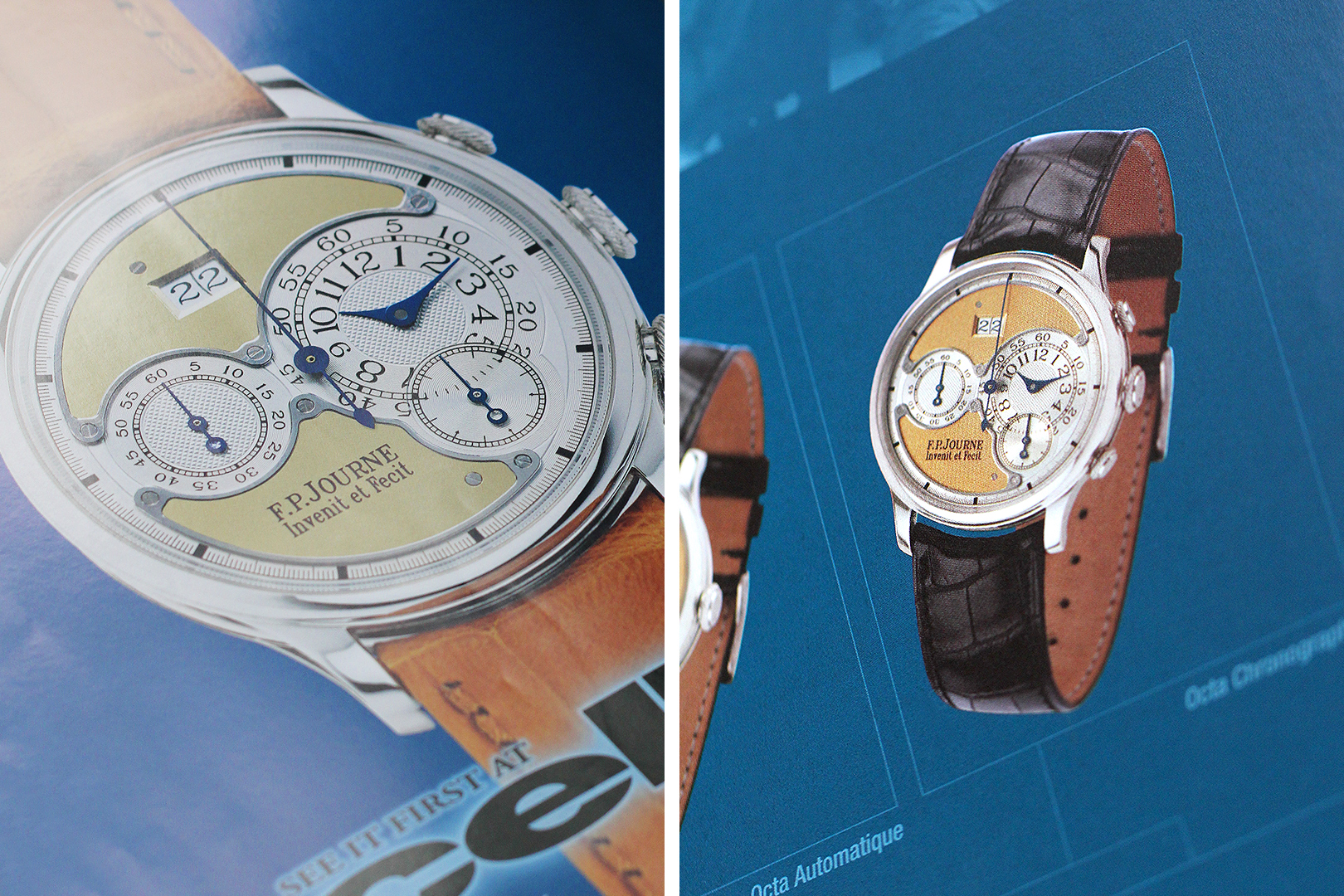
i. Hands
We believe there to be two sets of distinctive hands “short thick” vs. “long thin”. The first illustration below displays the differences between the two sets. It might be interesting to note that serial numbers are not always manufactured in chronological order. We would think that the ‘short thick’ hands were used first whereas the ‘long thin’ were used later on.

ii. Silver Vs. Matt Finish
On the very early examples, we have identified that the base of the dial appears to be silver, over time, they have a tendency to develop patina “brownish hue” due to a layer of lacquer. The overall dial also has a shimmery base (the white parts) and usually tends to patinate. The surrounding frames of the dial found around the hours, minutes and seconds seem to be more prominent than later examples. As the production capabilities mature the frequency of shimmery dials wane and transition into matt white dials.
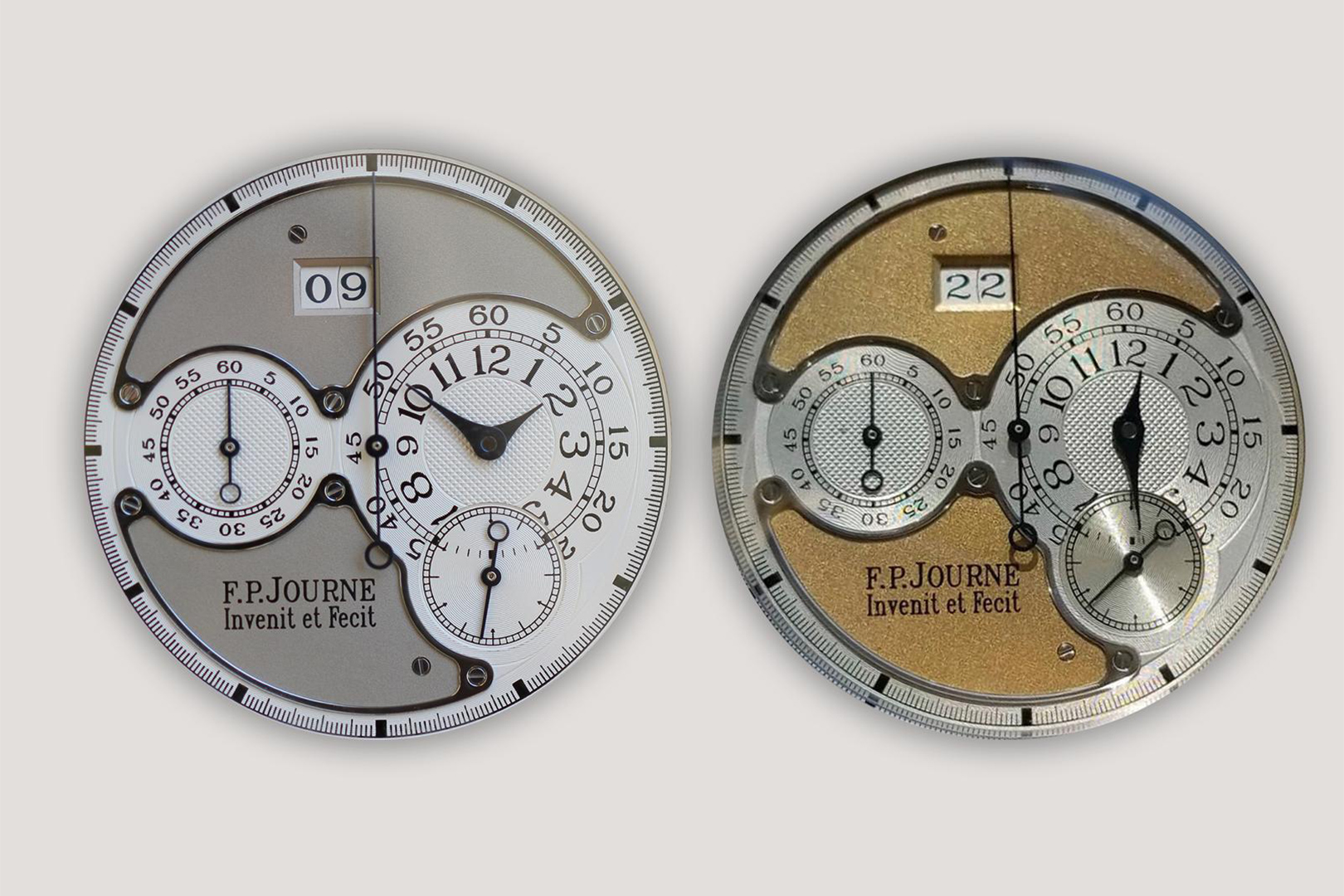
iii. Placement of the 45
We have noticed that most dial layouts remain somewhat identical, the only difference being the placement of the 45-minute marker. The placement varies throughout the examples, there is no set rule as to the placement of the 45, some are on the brim of the guilloché and others are more central.
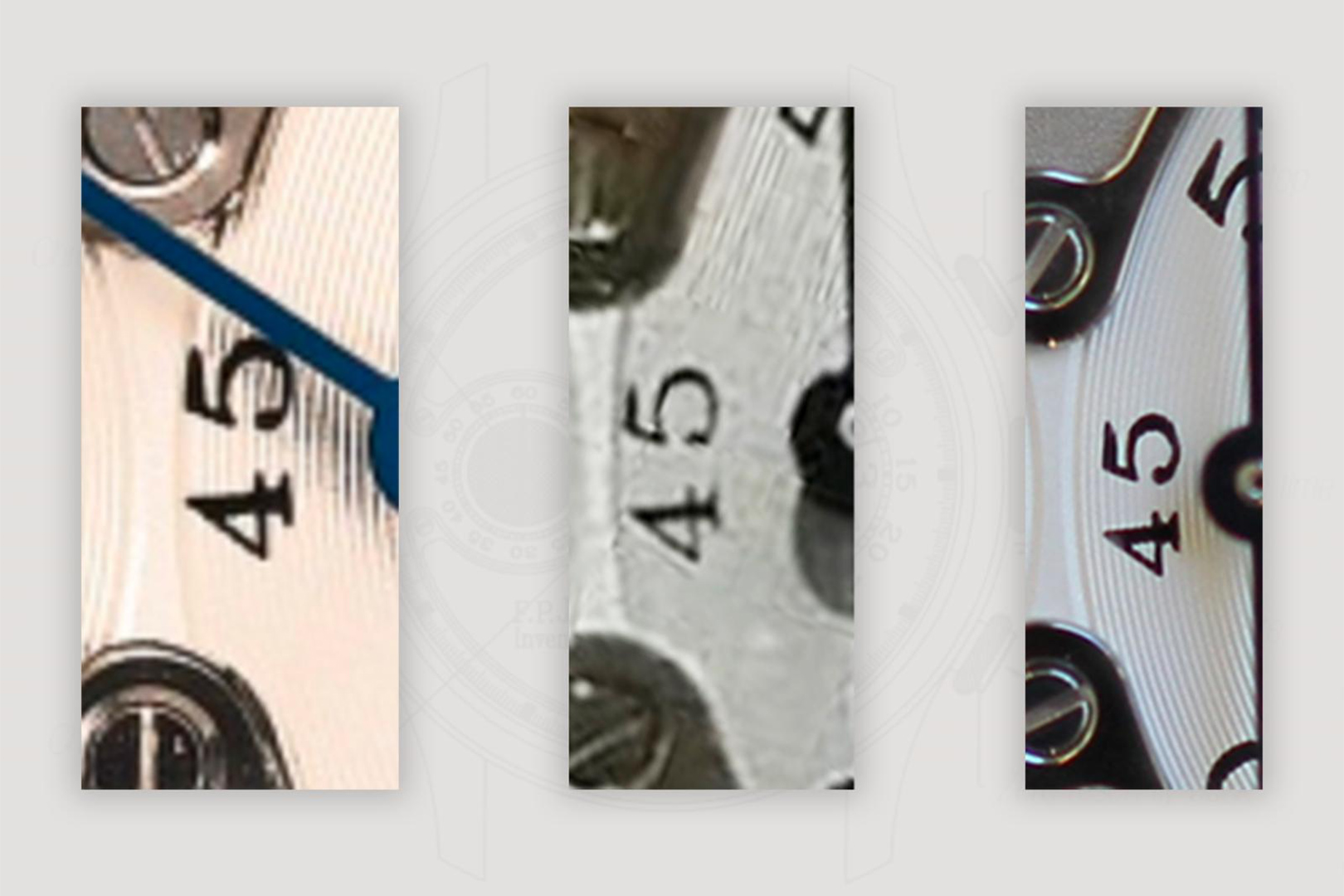
Auction Results
We have only considered the results of leading auction houses which include: Antiquorum, Christie’s, Phillips and Sotheby’s.
|
Auction House |
Date |
Price Sold |
Serial No |
Movement |
Brass |
Ruth |
Rose |
Case |
Dial |
| Antiquorum |
01/12/2004 | 46,000 |
32/99-02C | 1300 |
X | Platinum | Ruthenium | ||
| Sothebys |
17/05/2005 | NA |
99/99-02C | 1300 |
X | Platinum | Ruthenium | ||
| Antiquorum |
28/09/2005 | 41,400 |
99/99-02C | 1300 |
X | Platinum | Ruthenium | ||
| Sothebys |
05/12/2005 | 33,000 |
47/99-02C | 1300 |
X | Platinum | Ruthenium | ||
| Antiquorum |
15/03/2006 | 35,400 |
231-04C | 1300.2 |
X | Red Gold | Rose Gold | ||
| Antiquorum |
15/03/2006 | 27,140 |
082-03C | 1300 |
X | Platinum | White Gold | ||
| Christies |
31/05/2007 | 42,260 |
88/99-02C | 1300 |
X | Platinum | Ruthenium | ||
| Antiquorum |
11/11/2007 | 35,400 |
065-02C | 1300 |
X | Red Gold | Rose Gold | ||
| Sothebys |
23/04/2008 | 25,000 |
094-03C | 1300 |
X | Platinum | White Gold | ||
| Antiquorum |
11/05/2008 | 28,800 |
242-C | 1300.2 |
X | Platinum | NA | ||
| Antiquorum |
11/05/2008 | 36,000 |
108-03C | 1300 |
X | Platinum | Rose Gold | ||
| Christies |
16/11/2009 | 36,251 |
045-02C | 1300 |
X | Platinum | Rose Gold | ||
| Christies |
15/12/2009 | 47,500 |
59/99-02C | 1300 |
X | Platinum | Ruthenium | ||
| Christies |
02/06/2010 | 36,889 |
130-05C | 1300.2 |
X | Platinum | White Gold | ||
| Antiquorum |
10/06/2010 | 21,000 |
142-02C | 1300 |
X | Red Gold | White Gold | ||
| Christies |
30/05/2011 | 57,831 |
05/99-02C | 1300 |
X | Platinum | Ruthenium | ||
| Sothebys |
10/06/2011 | 35,327 |
238-C | 1300.2 |
X | Red Gold | White Gold | ||
| Antiquorum |
14/09/2011 | 35,000 |
139-02C | 1300.2 |
X | NA | Rose Gold | ||
| Christies |
30/11/2011 | 38,592 |
82/99-02C | 1300 |
X | Platinum | Ruthenium | ||
| Sothebys |
06/12/2011 | 37,500 |
21/99-02C | 1300 |
X | Platinum | Ruthenium | ||
| Christies |
16/12/2011 | 37,500 |
14/99-02C | 1300 |
X | Platinum | Ruthenium | ||
| Sothebys |
04/04/2012 | 30,585 |
028-02C | 1300 |
X | Platinum | Yellow Gold | ||
| Antiquorum |
12/06/2012 | 42,500 |
104-03C | 1300 |
X | Platinum | Yellow Gold | ||
| Christies |
13/06/2012 | 40,000 |
65/99-02C | 1300 |
X | Platinum | Ruthenium | ||
| Sothebys |
08/10/2012 | NA |
138-05C | 1300.2 |
X | Platinum | White Gold | ||
| Antiquorum |
11/11/2012 | 29,000 |
038-02C | 1300 |
X | Platinum | Yellow Gold | ||
| Christies |
11/11/2012 | 36,904 |
163-05C | 1300.2 |
X | Red Gold | White Gold | ||
| Christies |
14/12/2012 | 27,500 |
046-02C | 1300 |
X | Platinum | Yellow Gold | ||
| Antiquorum |
22/02/2014 | 33,900 |
063-02C | 1300 |
X | Red Gold | Rose Gold | ||
| Christies |
17/06/2014 | 27,500 |
26/99-02C | 1300 |
X | Platinum | Ruthenium | ||
| Christies |
09/12/2014 | 50,000 |
59/99-02C | 1300 |
X | Platinum | Ruthenium | ||
| Sothebys |
10/12/2014 | 25,000 |
030-02C | 1300 |
X | Platinum | Yellow Gold | ||
| Antiquorum |
15/03/2015 | 31,000 |
038-02C | 1300 |
X | Platinum | Yellow Gold | ||
| Antiquorum |
15/03/2015 | 31,000 |
121-05C | 1300 |
X | Platinum | White Gold | ||
| Sothebys |
06/10/2015 | 25,806 |
23/99-02C | 1300 |
X | Platinum | Ruthenium | ||
| Phillips |
01/12/2015 | 27,348 |
157-C | 1300.2 |
X | Platinum | White Gold | ||
| Christies |
15/03/2016 | 32,500 |
081-02C | 1300 |
X | Platinum | Yellow Gold | ||
| Sothebys |
14/05/2016 | NA |
129-05C | 1300.2 |
X | Platinum | White Gold | ||
| Christies |
16/05/2016 | 28,141 |
004-05C | 1300.2 |
X | Platinum | White Gold | ||
| Sothebys |
15/11/2016 | 40,158 |
66/99-02C | 1300 |
X | Platinum | Ruthenium | ||
| Sothebys |
15/11/2016 | 32,628 |
129-05C | 1300.2 |
X | Platinum | White Gold | ||
| Sothebys |
14/05/2017 | 27,300 |
129-05C | 1300.2 |
X | Platinum | White Gold | ||
| Sothebys |
13/11/2017 | NA |
XX/02-C | 1300 |
X | Platinum | Ruthenium | ||
| Christies |
13/11/2017 | 27,572 |
231-04C | 1300.2 |
X | Red Gold | Rose Gold | ||
| Christies |
13/11/2017 | 33,838 |
090-03C | 1300 |
X | Platinum | White Gold | ||
| Christies |
27/11/2017 | 35,250 |
32/99-02C | 1300 |
X | Platinum | Ruthenium | ||
| Christies |
27/05/2019 | 35,034 |
035-02C | 1300 |
X | Platinum | White Gold | ||
| Christies |
23/11/2019 | 87,860 |
045-02C | 1300 |
X | Platinum | Rose Gold | ||
| Phillips |
12/12/2020 | 252,000 |
143-02C | 1300 |
X | Rose | White Gold | ||
| Phillips |
05/06/2021 | 210,500 |
243-C | 1300.3 |
X | Platinum | White Gold |
* Availability of Data – The data above was formulated on the basis of the reported sales of the said auction houses. We do not exclude the possibility of certain lots being inaccurate. It is important to note that auctions occur on a global scale and currencies fluctuate, for the sake of convenience we have converted all values into USD (price sold). For example, if a sale took place in Hong Kong on 05/12/05 we would identify the appropriate rate at that time with the help of XE historical converter and use the date of the sale as the base for the currency exchange.
Auction Analysis:
The table above represents every auction result to date for the Octa Chronographe, in total 50 results were registered with 4 of them failing to sell. The pie chart below labelled “Auction: Movement Breakdown” demonstrates the different movements sold at auction. The most common are brass movements followed by rose and ruthenium. 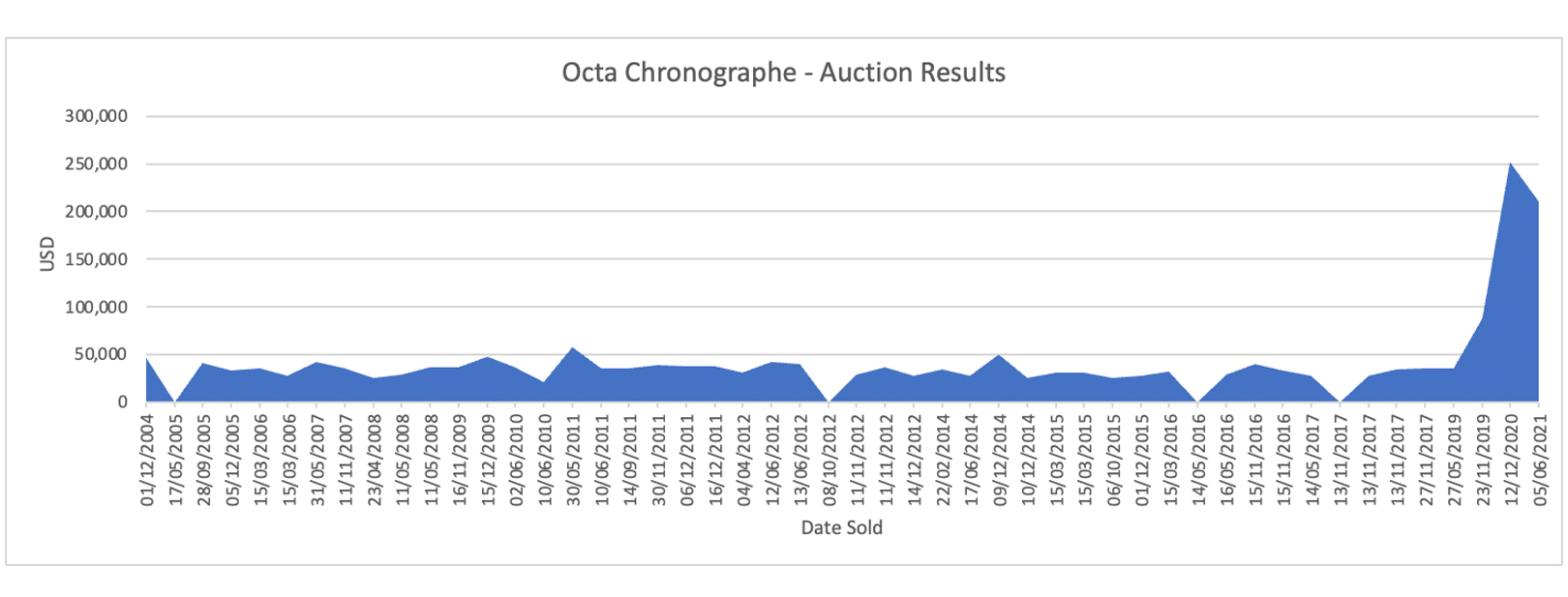
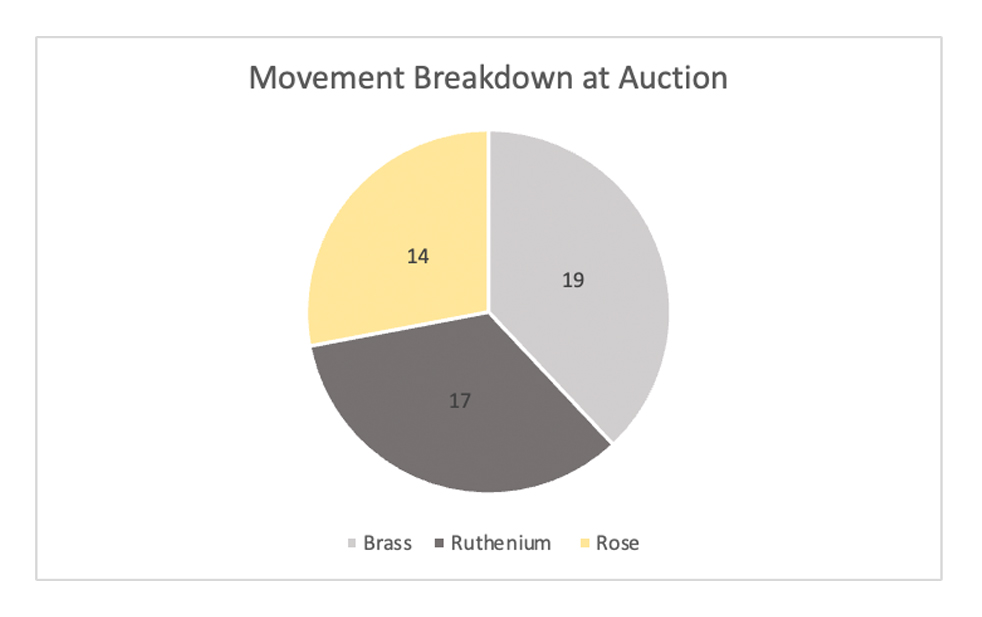
It is important to note that no limited edition or series, apart from the Ruthenium limited edition, has come up publicly for sale. We do know of several that have traded hands privately, namely, the Swiss Fine Timepieces. We omitted the most recent result of Phillips dated 07/11/2021 as this result was an outlier. We did observe that the case dates from 2003 (001-03C) and the dial would appear to be a later example.
We will continue to add to this study and update the auction results.

